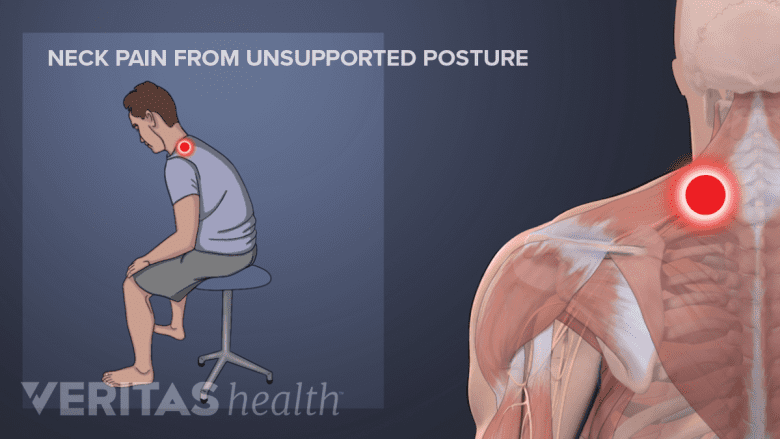Nonsurgical treatments, such as physical therapy, pain medication, activity modification, and/or epidural injections are typically tried first for cervical foraminal stenosis. While cervical foraminal stenosis can typically be managed successfully with a combination of nonsurgical treatments, surgery may be considered in cases when severe pain and/or neurological deficits continue to worsen.
Common nonsurgical treatments used to alleviate pain and neurological symptoms resulting from cervical foraminal stenosis are outlined below.
In This Article:
- Cervical Foraminal Stenosis
- Cervical Foraminal Stenosis Symptoms
- Cervical Foraminal Stenosis Causes and Diagnosis
- Cervical Foraminal Stenosis Treatment
- Cervical Foraminal Stenosis Surgery
Physical Therapy
Gentle stretches promote flexibility and reduce muscle tightness in the neck.
Long-term treatment plans for cervical foraminal stenosis typically include physical therapy. A physical therapist or other health professional can design a stretching and strengthening program that meets the patient’s specific needs. In general, improving the neck’s strength and flexibility helps to better support the spine, which may relieve pain.
See Neck Strengthening Exercises
It is important to check with a doctor before starting a new exercise program. Also, any exercise or stretching that increases pain or leads to flare-ups needs to be avoided. A trained medical professional may be able to help modify some exercises so they can be done without worsening the pain.
See Physical Therapy for Neck Pain Relief
Activity Modification

Poor posture, such as slouching and leaning forward while using a computer, exacerbates symptoms.
It is recommended to avoid or limit activities that trigger flare-ups or worsen symptoms. Examples of activities that may need to be modified or avoided include:
- Heavy lifting, such as during manual labor
- Running or jogging, such as during sports
- Twisting or bending the neck to one side, such as while getting dressed or driving
- Poor posture, such as sitting with hunched shoulders and forward head posture while looking at a computer screen
While short periods of rest may be recommended, it is advised to resume some activities as soon as possible. Too much rest and activity avoidance can lead to the neck muscles becoming deconditioned, which can lead to more stiffness and pain.
Medications

NSAIDs provide anti-inflammatory effects and alleviate neck pain.
Common medications used to help reduce foraminal stenosis pain may include:
- Acetaminophen works by way of the brain and spinal cord to help relieve pain. It is available over-the-counter or in prescription strength.
- Nonsteroidal anti-inflammatory drugs (NSAIDs) help to reduce inflammation and pain. Examples of NSAIDs include aspirin, ibuprofen, naproxen, and celecoxib. NSAIDs are available over-the-counter or via prescription.
For severe episodes of nerve-related pain, a physician may prescribe a short-term course of opioids, muscle relaxers, or nerve-desensitizing medication.
Potential risks and side effects from medications must always be considered. Regardless of whether a medication is over-the-counter or prescription, warning labels must be read and followed carefully. It is also important to let the doctor or pharmacist know about all medications being taken and any medication allergies.
See Opioid Medication Potential Risks and Complications
Cervical Epidural Steroid Injections

Cervical epidural steroid injections reduce inflammation and control painful symptoms.
A trained physician, using x-ray guidance (fluoroscopy) and contrast dye, can inject a corticosteroid solution into the spinal canal’s epidural space. The goal of epidural steroid injection for foraminal stenosis is to alleviate inflammation of the nearby nerve root.
Watch Cervical Epidural Steroid Injection Video
When an epidural steroid injection results in a reduction in pain, the effect is usually temporary. During this temporary period of pain relief, it may be recommended to continue with a physical therapy program. Increasing the neck’s strength and flexibility may lead to better neck function and longer-lasting pain relief.
See How Epidural Steroid Injections Work
In rare cases, serious side effects from epidural steroid injections have been reported. The potential risks and benefits of injections must be discussed with a medical professional before deciding to have this treatment.
Cervical Traction
This treatment typically involves strapping a harness to the neck, chin, and/or forehead, then using a mechanical device to gently lift the head upward. The goal of cervical traction is to reduce pressure on the discs and nerve roots by gently pulling the vertebrae further apart. While this treatment may offer relief, the therapeutic benefit is usually temporary because the nerves become compressed again after the treatment is over.
Cervical traction is typically started under the guidance of a trained medical professional, such as during a doctor visit or physical therapy session. If cervical traction provides pain relief, some people may choose to get a home device to perform this treatment on their own. Traction is not advised for people who have weakened bones, neck instability, or previous neck surgery. Cervical traction is usually not recommended in cases where there is suspicion for traumatic ligamentous injury and/or connective tissue disorders like Ehlers-Danlos syndrome, which can result in ligamentous laxity.
Cervical foraminal stenosis and related pain can typically be managed with a combination of nonsurgical treatments. In cases when neurological deficits and/or severe pain continue to worsen despite treatments, surgery may be considered.

